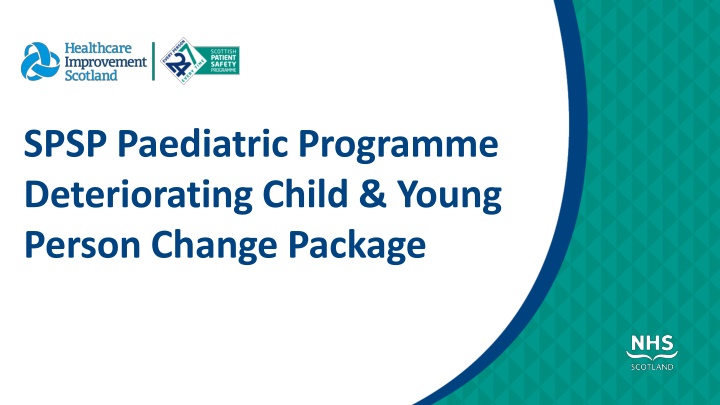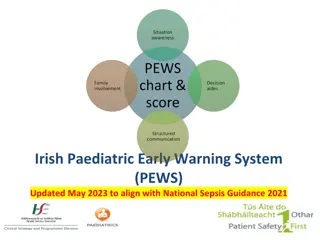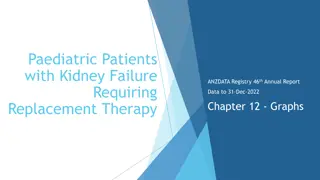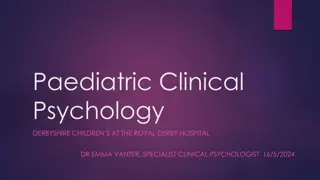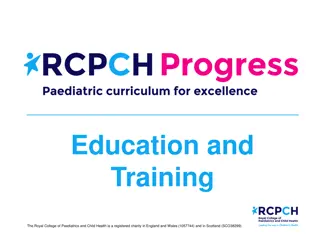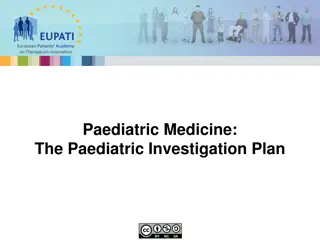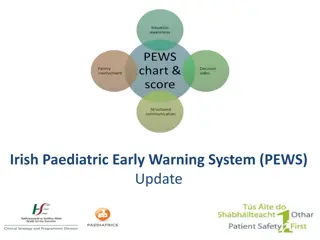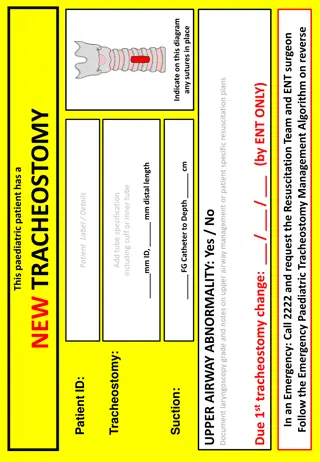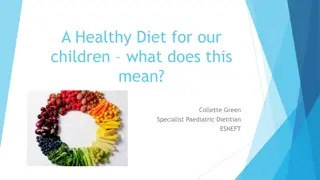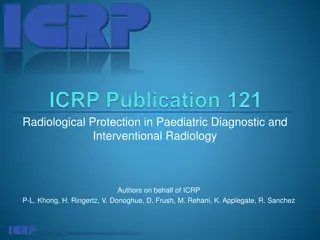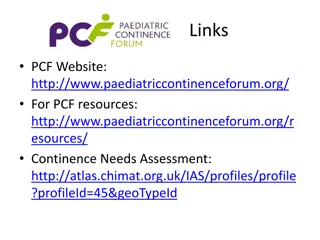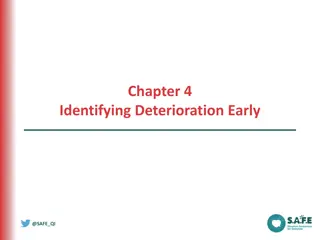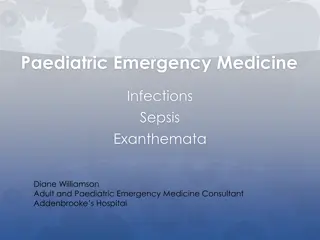Paediatric Deteriorating Child & Young Person Change Package
Welcome to the paediatric programme designed to support teams in improving the recognition, response, and review of deteriorating children and young individuals. This interactive resource includes driver diagrams, change ideas, guides, tools, and measurement guidance. Developed with input from clinical experts, it aims to reduce harm from deterioration by enhancing care practices.
Download Presentation

Please find below an Image/Link to download the presentation.
The content on the website is provided AS IS for your information and personal use only. It may not be sold, licensed, or shared on other websites without obtaining consent from the author.If you encounter any issues during the download, it is possible that the publisher has removed the file from their server.
You are allowed to download the files provided on this website for personal or commercial use, subject to the condition that they are used lawfully. All files are the property of their respective owners.
The content on the website is provided AS IS for your information and personal use only. It may not be sold, licensed, or shared on other websites without obtaining consent from the author.
E N D
Presentation Transcript
SPSP Paediatric Programme Deteriorating Child & Young Person Change Package
Introduction Welcome to the deteriorating child and young person change package The aim of the deteriorating child and young person change package is to support teams to improve the recognition, response and review of the deteriorating child and young person. A change package consists of a number of measures supported by activities that, when tested and implemented, bring about improvement. It brings together what is known about best practices and processes based on evidence from literature, research, and the experiences of others. Why have we developed this change package? This change package is for paediatric teams participating in deteriorating child and young person improvement work. It will support teams to use quality improvement methods to improve the recognition, response and review of the deteriorating child and young person. How was it developed? This change package was co-designed with clinical and quality improvement experts from NHS boards. The clinical experts were from a range of disciplines. Expert Reference Groups (ERG) were convened in March 2023 with representation from across NHS Scotland. 2
Contents and how to use the package What is included in this change package? Driver diagram Change ideas Guides, tools and signposts to the supporting evidence and examples of good practice Guidance to support measurement Guidance on using this change package This change package is a resource to support NHS boards with improvement in the recognition, response and review of the deteriorating child and young person. It is not expected for teams to work simultaneously on all aspects of the driver diagram. It is designed to assist teams in identifying areas for improvement relevant to their local context. The change ideas and measures are not exhaustive, and it is expected that teams will develop their own to support their identified areas for improvement. We would encourage teams to seek support from their local quality improvement teams in the development of additional measures if required. Using this package This is an interactive document; clicking on the primary/secondary driver will take you to additional information, including tools and resources relating to that driver. At the top of each page of the secondary drivers, there is an arrow and home button . The arrow button will take you back to the primary driver page, and the home button will take you to the main Driver Diagram page. 3
Project aim To reduce harm from deterioration by improving the recognition, response and review of the deteriorating child and young person** Setting a project aim All quality improvement projects should have an aim that is Specific, Time bound, Aligned to the NHS board s objectives and Numeric (STAN). The national aim for SPSP Paediatric Deteriorating Child & Young Person is: By [locally agreed %] by 31st March 2025 4
Core programme measures Essentials of Safe Care Driver Diagram Use of correct age-related PEWS chart** To reduce harm from deterioration by improving the recognition, response and review of the deteriorating child and young person Reliable use of PEWS observations** Reliable scoring of PEWS** Locally agreed measures should include: Reliable response to children and young people who trigger PEWS** **This data is already collected as part of an existing Excellence in Care measure 5
Driver diagram and change ideas What is a driver diagram? A driver diagram visually presents an organisation or team s theory of how an improvement goal will be achieved. It articulates which parts of the system need to change in which way and includes ideas of how to make this happen. It is used to help plan improvement projects and ensure team engagement. The primary drivers are the key components of the system that need to change to deliver the aim. The secondary drivers are the processes that influence the primary drivers. Changing the processes outlined in the secondary drivers should change the primary drivers and deliver the aim. Change ideas Change ideas are specific practical changes the project team can make to alter the processes in the secondary drivers. The following pages provide change ideas to support improvement in the recognition, response and review of the deteriorating child and young person. They are grouped by the primary driver that they influence. Project teams should select change ideas to test. A range of change ideas will be needed to ensure there are changes to all primary drivers. This change package does not contain an exhaustive list of change ideas. Project teams can also generate their own change ideas that will help drive change in the secondary drivers. One way to generate ideas is to ask, How might we? For example, How might we engage with children and young people and their families to improve the experience of care when in hospital? 6
2023 Deteriorating Child & Young Person Driver Diagram Essentials of Safe Care Driver Diagram Which requires What are we trying to achieve We need to ensure Patients, families and carers are listened to and included Person-centred care planning Person-centred care* Anticipatory care planning & CYPADM Discussions with families are well managed To reduce harm from deterioration by improving the recognition, response and review of the deteriorating child and young person** Observations using PEWS (Scotland) Action on staff concern Action on patient, family and carer concern Recognition of acute deterioration Timely review by appropriate decision maker Assessment for causes of acute deterioration Escalation Regular review and assessment Standardised, structured response and review By [locally agreed %] by 31st March 2025 Interdisciplinary teamwork and collaboration* Safe communication across care pathways* Use of standardised communication tools* Effective communication in different situations* Psychological safety for staff* Staff wellbeing* Safe Staffing* System for learning* *Essentials of Safe Care **Measurements may include existing Excellence in Care data Leadership to support a culture of safety at all levels* 7
Primary Driver Person-centred care Secondary drivers Change ideas Principles of Trauma Informed Practice included in local education programmes Patient, families and carers are listened to and included Access to tools, resources and education to support compassionate care Use of standardised tools to include the voice of the child/young person Use of what matters to me? Use of patient passports Local mechanism to discuss environmental needs of the child/young person Local method for documenting unique physiological baseline Use of specialist resources to support care-experienced young people Person-centred care planning CYPADM and anticipatory care plans discussed in huddles and handovers Use of tools for anticipatory care planning e.g. ReSPECT, CHAS Use of tools & resources for setting and reviewing goals & treatment plans Anticipatory care planning & CYPADM Access to tools and resources to support difficult conversations Discussions with families are well managed Identified area to hold sensitive conversations Local process to help families identify key clinicians 8
Person-centred care Secondary drivers Change ideas Principles of Trauma Informed Practice included in local education programmes Use of standardised tools to include the voice of the child/young person Access to tools, resources and education to support compassionate care Patient, families and carers are listened to and included Use of what matters to me? Use of patient passports Evidence and Guidelines: Heath G, Montgomery H, Eyre C, Cummins C, Pattison H, Shaw R. Developing a Tool to Support Communication of Parental Concerns When a Child is in Hospital Healthcare (Basel). 2016 Jan 13;4(1):9. Tools and Resources: Children with Exceptional Healthcare Needs (CEN) Managed Clinical Network, NHS Education for Scotland. eLearning Modules. 2023; Available from: https://learn.nes.nhs.scot/60619. Accessed 13th July, 2023 Healthcare Improvement Scotland. What matters to you? 2023; Available from: https://www.whatmatterstoyou.scot/. Accessed 13th July, 2023 PAMIS: promoting a more inclusive society. PAMIS Digital Passports. 2023; Available from: https://pamis.org.uk/services/digital-passports/.Accessed 13th July, 2023 NHS National Education for Scotland. National trauma training programme. 2023; Available from: https://learn.nes.nhs.scot/37896.Accessed 13th July, 2023. The Highland Council Comhairle na G idhealtachd. Tools for gathering the views of children and young people. 2020; Available from: https://highlandcouncilpsychologicalservice.store/publications/gathering-the-views-of-children-and-young-people/.Accessed 13th July, 2023. Children with Exceptional Healthcare Needs (CEN) Managed Clinical Network. Communicating with Children. 2019; Available from: https://www.cen.scot.nhs.uk/definition-for-children-with- complex-and-exceptional-healthcare-needs/communicating-with-children/.Accessed 13th July, 2023. Royal College of Paediatrics and Child Health. RCPCH &Us. Available from: https://www.rcpch.ac.uk/work-we-do/rcpch-and-us.Accessed 3rd August, 2023. 9
Person-centred care Secondary drivers Change ideas Local mechanism to discuss environmental needs of the child/young person Use of specialist resources to support care-experienced young people Local method for documenting unique physiological baseline Person-centred care planning Evidence and Guidelines: Health Foundation. Person-Centred Care Made Simple. 2016; Available from: https://www.health.org.uk/publications/person-centred-care-made-simple. Accessed 15th September, 2023 Tools and Resources: Healthcare Improvement Scotland. National Paediatric Early Warning Score Chart Training Package. 2017; Available from: https://ihub.scot/improvement-programmes/scottish-patient-safety- programme-spsp/maternity-and-children-quality-improvement-collaborative-mcqic/paediatric-care/paediatric-early-warning-score-pews/.Accessed 13th July, 2023. NHS Education for Scotland, PAMIS: promoting a more inclusive society. Your Posture Matters. 2023; Available from: https://learn.nes.nhs.scot/60811.Accessed 13th July, 2023. Who Cares? Scotland. Who Cares? Scotland Resource Library. 2022; Available from: https://www.whocaresscotland.org/resources-learning/resource-library/.Accessed 13th July, 2023 10
Person-centred care Secondary drivers Change ideas CYPADM and anticipatory care plans discussed in huddles and handovers Use of tools & resources for setting and reviewing goals & treatment plans Use of tools for anticipatory care planning e.g. ReSPECT, CHAS Anticipatory care planning & CYPADM Evidence and Guidelines: Social Care Institute for Excellence. Mental Capacity Act: Care Planning, Involvement and Person-centred Care. 2017; Available from: https://www.scie.org.uk/mca/practice/care-planning/person- centred-care. Accessed 13th July, 2023. Harrop EJ, Boyce K, Beale T, et al. Fifteen-minute consultation: Developing an advance care plan in partnership with the child and family. Arch Dis Child Educ Pract Ed. 2018;103:282-287. Tools and Resources: Resuscitation Council UK. ReSPECT. 2023; Available from: https://www.resus.org.uk/respect.Accessed 13th July, 2023. CHAS: Children's Hospices Across Scotland. End of life care. 2023; Available from: https://www.chas.org.uk/how-we-help/medical-care/end-of-life.Accessed 13th July, 2023. Healthcare Improvement Scotland. Anticipatory Care Planning toolkit. 2021; Available from: https://ihub.scot/project-toolkits/anticipatory-care-planning-toolkit/anticipatory-care-planning- toolkit/.Accessed 13th July, 2023. 11
Person-centred care Secondary drivers Change ideas Access to tools and resources to support difficult conversations Identified area to hold sensitive conversations Local process to help families identify key clinicians Discussions with families are well managed Evidence and Guidelines: Martin AE, Beringer AJ. Advanced care planning 5 years on: An observational study of multi-centred service development for children with life-limiting conditions. Child Care Health Dev. 2019 Mar;45(2):234-240. PMID: 30693557. Linney M, Hain RDW, Wilkinson D, et al. Achieving consensus advice for paediatricians and other health professionals: on prevention, recognition and management of conflict in paediatric practice. Arch Dis Child. 2019;104:413-416. Tools and Resources: NHS Education for Scotland, Dr Lara Mitchell. Difficult Conversations - Why we need to talk about dying. 2023; Available from: https://learn.nes.nhs.scot/28261/quality-improvement- zone/learning-programmes/scottish-quality-and-safety-sqs-fellowship-programme/difficult-conversations-why-we-need-to-talk-about-dying.Accessed 13th July, 2023. Royal College of Paediatrics and Child Health. Health Inequalities Tool 2: Develop Clinical Skills in Talking with Families [online]. Available from: https://www.rcpch.ac.uk/resources/health- inequalities-tool-2-develop-clinical-skills-talking-families. Accessed 15th September, 2023. 12
Primary Driver Recognition of acute deterioration Secondary drivers Change ideas Observations using PEWS (Scotland) Locally agreed education & training for PEWS Consideration of digital PEWS or E-Obs Reliable use of PEWS Locally agreed escalation process that considers clinical judgment as well as PEWS Action on staff concern Use of tools for children/young people with communication difficulties Discussions with families enable them to recognise and report deterioration Action on patient, family and carer concern Clear, structured system for families to escalate concerns 13
Recognition of acute deterioration Secondary drivers Change ideas Locally agreed education & training for PEWS Observations using PEWS (Scotland) Consideration of digital PEWS or E-Obs Reliable use of PEWS Evidence and Guidelines: Tomasi JN, Hamilton MV, Fan M, Pinkney SJ, Middaugh KL, Parshuram CS, et al. Assessing the electronic Bedside Paediatric Early Warning System: A simulation study on decision-making and usability. International journal of medical informatics (Shannon, Ireland) 2020 Jan;133:103969. Kramer AA, Sebat F, Lissauer M. A review of early warning systems for prompt detection of patients at risk for clinical decline. J Trauma Acute Care Surg. 2019;87(Suppl 15):S67 S73. Tools and Resources: Healthcare Improvement Scotland. Paediatric Early Warning Score (PEWS). 2021; Available from: https://ihub.scot/improvement-programmes/scottish-patient-safety-programme- spsp/maternity-and-children-quality-improvement-collaborative-mcqic/paediatric-care/paediatric-early-warning-score-pews/.Accessed 13th July, 2023 Royal College of Nursing. Standards for Assessing, Measuring and Monitoring Vital Signs in Infants, Children and Young People 2. 2017 12th May. Healthcare Improvement Scotland. National Paediatric Early Warning Score Chart Training Package. 2017; Available from: https://ihub.scot/improvement-programmes/scottish-patient-safety- programme-spsp/maternity-and-children-quality-improvement-collaborative-mcqic/paediatric-care/paediatric-early-warning-score-pews/.Accessed 13th July, 2023 14
Recognition of acute deterioration Secondary drivers Change ideas Locally agreed escalation process that considers clinical judgment as well as PEWS Action on staff concern Evidence and Guidelines: Jensen CS, Lisby M, Kirkegaard H, Loft MI. Signs and symptoms, apart from vital signs, that trigger nurses concerns about deteriorating conditions in hospitalized paediatric patients: A scoping review. Nursing Open 2021 -11-10;9(1):57. 15
Recognition of acute deterioration Secondary drivers Change ideas Use of tools for children/young people with communication difficulties Discussions with families enable them to recognise and report deterioration Clear, structured system for families to escalate concerns Action on patient, family and carer concern Evidence and Guidelines: Gaskin KL, Smith L, Wray J. An improved congenital heart assessment tool: a quality improvement outcome. Cardiology in the young 2023 Apr 01,;33(4):551-556. Allen D, Lloyd A, Edwards D, Grant A, Hood K, Huang C, et al. Development, implementation and evaluation of an early warning system improvement programme for children in hospital: the PUMA mixed-methods study. Health and Social Care Delivery Research 2022 Jan;10(1):1-308. Gill FJ, Leslie GD, Marshall AP. Parent escalation of care for the deteriorating child in hospital: A health care improvement study. Health Expect 2019;22(5):1078. Albutt AK, O'Hara JK, Conner MT, et al. Is there a role for patients and their relatives in escalating clinical deterioration in hospital? A systematic review. Health Expect. 2017;20:818 825. Tools and Resources: Congenital Cardiac Nurses Association. Congenital Heart Assessment Tool E-Resource. 2022; Available from: http://www.ccn-a.co.uk/events/chat-tool.Accessed 13th July, 2023 Hunter New England Local Health District. REACH - Patient and Family Activated Escalation. 2023; Available from: https://www.hnehealth.nsw.gov.au/what-to-expect-in-hospital/reach-patient- and-family-activated-escalationAccessed 13th July, 2023. Starship Child Health. K rero Mai (Talk to me). 2019; Available from: https://starship.org.nz/guidelines/korero-mai-talk-to-me/.Accessed 13th July, 2023. Institute of Child Health, Royal College of Nursing Institute O. Paediatric Pain Profile. Available from: https://ppprofile.org.uk/. Accessed 13th July, 2023. 16
Primary Driver Standardised, structured response & review Secondary drivers Change ideas Education programmes to include trigger, escalation and response process Use of standardised structured ward rounds Locally agreed process for timely review Timely review by appropriate decision maker Use of locally agreed watchers bundle Assessment for causes of acute deterioration Use of evidence- based tools e.g. Sepsis 6 Use of existing evidence based guidelines e.g. bronchiolitis Admission information includes how to use call system effectively Locally agreed process for escalation Use of hospital huddles to escalate care Escalation Local escalation process includes follow-up clinical review Regular review and assessment 17
Standardised, structured response & review Secondary drivers Change ideas Education programmes to include trigger, escalation and response process Timely review by appropriate decision maker Use of standardised structured ward rounds Locally agreed process for timely review Use of locally agreed watchers bundle Evidence and Guidelines: Allen D, Lloyd A, Edwards D, Grant A, Hood K, Huang C, et al. Development, implementation and evaluation of an early warning system improvement programme for children in hospital: the PUMA mixed-methods study. Health and Social Care Delivery Research 2022 Jan;10(1):1-308. National Institute for Health and Care Excellence. Chapter 28 Structured ward rounds. 2018; Available from: https://www.nice.org.uk/guidance/ng94/evidence/. Accessed 18th September 2023. Tools and Resources: Royal College of Paediatrics and Child Health. Safe system framework for children at risk of deterioration. 2022; Available from: https://www.rcpch.ac.uk/resources/safe-system-framework- children-risk-deterioration#education-and-training.Accessed 13th July, 2023. 18
Standardised, structured response & review Secondary drivers Change ideas Assessment for causes of acute deterioration Use of evidence- based tools e.g. Sepsis 6 Evidence and Guidelines: Academy of Medical Royal Colleges. Statement on the initial antimicrobial treatment of sepsis. 2022; Available from: https://www.aomrc.org.uk/reports-guidance/statement-on- the-initial-antimicrobial-treatment-of-sepsis-v2-0/. Accessed 18th September 2023. National Institute for Health and Care Excellence. Suspected sepsis: recognition, diagnosis and early management. 2024; Available at: https://www.nice.org.uk/guidance/ng51. Accessed 5th March 2024. Tools and Resources: Healthcare Improvement Scotland. Sepsis Literature and Resources List. 2020; Available from: https://ihub.scot/project-toolkits/sepsis-toolkit/sepsis-toolkit/education-and- awareness/. Accessed 13th July, 2023. 19
Standardised, structured response & review Secondary drivers Change ideas Use of existing evidence based guidelines e.g. bronchiolitis Admission information includes how to use call system effectively Use of hospital huddles to escalate care Locally agreed process for escalation Escalation Evidence and Guidelines: National Institute for Health and Care Excellence. NICE Guidance: Children and Young People. 2023; Available from: https://www.nice.org.uk/Guidance/population- groups/children-and-young-people.Accessed 13th July, 2023 Tools and Resources: Healthcare Improvement Scotland. Paediatric Early Warning Score (PEWS). 2021; Available from: https://ihub.scot/improvement-programmes/scottish-patient-safety-programme- spsp/maternity-and-children-quality-improvement-collaborative-mcqic/paediatric-care/paediatric-early-warning-score-pews/. Accessed 13th July, 2023. Royal College of Paediatrics and Child Health. National guidance for the management of children in hospital with viral respiratory tract infections. 2023; Available from: https://www.rcpch.ac.uk/resources/guidance-management-children-viral-respiratory-tract-infections. Accessed 13th July, 2023. Healthcare Improvement Scotland. Understanding the key components of effective morning Hospital Huddles. 2021; Available from: https://ihub.scot/media/8884/20211217- hospital-huddles-findings-and-core-elements-v10.pdf.Accessed 13th July, 2023 20
Standardised, structured response & review Secondary drivers Change ideas Local escalation process includes follow-up clinical review Regular review and assessment 21
Primary Driver Safe communication across care pathways Secondary drivers Change ideas Use of hospital huddles to improve situational awareness Locally agreed system of communication between teams Interdisciplinary teamwork and collaboration Use of MDT shared documentation Scotstar watchers bundle Use of standardised communication tools SBAR tool Effective MDT ward/unit safety huddles & briefs Procedures in place for communication between centres communication in different situations Mid-shift check ins 22
Safe communication across care pathways Secondary drivers Change ideas Use of hospital huddles to improve situational awareness Locally agreed system of communication between teams Interdisciplinary teamwork and collaboration Use of MDT shared documentation Scotstar watchers bundle Evidence and Guidelines: Theilen U, Leonard P, Jones P, Ardill R, Weitz J, Agrawal D, Simpson D. Regular in situ simulation training of paediatric medical emergency team improves hospital response to deteriorating patients. Resuscitation. 2013 Feb;84(2):218-22. Stocker M, Pilgrim SB, Burmester M, Allen ML, Gijselaers WH. Interprofessional team management in pediatric critical care: some challenges and possible solutions. J Multidiscip Healthc. 2016 Feb 24;9:47-58. Tools and Resources: Healthcare Improvement Scotland. Understanding the key components of effective morning Hospital Huddles. 2021; Available from: https://ihub.scot/media/8884/20211217-hospital-huddles- findings-and-core-elements-v10.pdf.Accessed 13th July, 2023. Institute for Healthcare Improvement. WIHI: Sustaining and Strengthening Safety Huddles. 2018; Available from: https://www.ihi.org/resources/Pages/AudioandVideo/WIHI-Sustaining-and- Strengthening-Safety-Huddles.aspx. Accessed 18th September 2023. 23
Safe communication across care pathways Secondary drivers Change ideas Use of standardised communication tools SBAR tool Evidence and Guidelines: Royal College of Nursing. Standards for Assessing, Measuring and Monitoring Vital Signs in Infants, Children and Young People 2. 2017 12th May. Tools and Resources: NHS Education for Scotland. Structured Handover Education Project. Available from: https://learn.nes.nhs.scot/704/patient-safety-zone/structured-handover-education-project.Accessed 13th July, 2023 24
Safe communication across care pathways Secondary drivers Change ideas Effective MDT ward/unit safety huddles & briefs Procedures in place for communication between centres communication in different situations Mid-shift check ins Evidence and Guidelines: Joseph MM, Mahajan P, Snow SK, Ku BC, Saidinejad M. Optimizing Pediatric Patient Safety in the Emergency Care Setting. Journal of emergency nursing 2022 Nov;48(6):652-665. Tools and Resources: NHS Education for Scotland. Leading for the Future: Communication Skills Resources [online]. 2018; Available from: https://learn.nes.nhs.scot/11233/leadership-and-management- programmes/leading-for-the-future/communication-skills-resources. Accessed 15th September, 2023. NHS Scotland Workforce. Guide to Supportive and Difficult Conversations [online]. Available from: https://workforce.nhs.scot/supporting-documents/guides/guide-to-supportive-and-difficult- conversations/. Accessed 15th September, 2023. Healthcare Improvement Scotland. Critical Situations: Management of Communication in Different Situations [online]. Available from: https://ihub.scot/improvement-programmes/scottish- patient-safety-programme-spsp/spsp-essentials-of-safe-care/safe-communications/critical-situations-management-of-communication-in-different-situations/. Accessed 15th September, 2023. Institute for Healthcare Improvement (IHI). Patient Safety Essentials Toolkit [online]. Available from: https://www.ihi.org/resources/Pages/Tools/Patient-Safety-Essentials-Toolkit.aspx. Accessed 15th September, 2023. 25
Primary Driver Leadership to support a culture of safety Secondary drivers Change ideas Create forums to allow workforce to generate improvement ideas Psychological safety for staff Visible supportive leadership Local mentoring system Use of standardized feedback tools e.g. iMatter Access to mental health first aiders Use of what matters to me Hot and cold debriefs Celebrate success Access to Peer Support Staff wellbeing Mechanism to identify staff operating out with their usual area Staff education & awareness about safe staffing act (2019) Effective rostering Real-time staff risk assessment Clinical supervision Safe Staffing Use of tools and resources to support patient safety e.g. NES Safety Culture Cards Involvement of resuscitation teams in improvement work Local system to learn from adverse events e.g. M&M, SAER s, Child Death Reviews Local system for learning and support for complaints e.g. care opinion Create opportunities to learn from excellence Use of simulation training System for learning 26
Leadership to support a culture of safety Secondary drivers Change ideas Create forums to allow workforce to generate improvement ideas Psychological safety for staff Visible supportive leadership Local mentoring system Evidence and Guidelines: NHS Providers. Psychological Safety and Why It Matters [online]. 2020; Available from: https://nhsproviders.org/news-blogs/blogs/psychological-safety-and-why-it-matters. Accessed 15th September, 2023. Edmondson A. Psychological Safety and Learning Behavior in Work Teams. Administrative Science Quarterly. 1999 Jun;44(2):350-383. Tools and Resources: Healthcare Improvement Scotland. The Essentials of Safe Care: Psychological Safety. 2021; Available from: https://ihub.scot/improvement-programmes/scottish-patient-safety-programme- spsp/spsp-essentials-of-safe-care/leadership-and-culture/psychological-safety/.Accessed 13th July, 2023. 27
Leadership to support a culture of safety Secondary drivers Change ideas Use of standardized feedback tools e.g. iMatter Access to mental health first aiders Celebrate success Use of what matters to me Hot and cold debriefs Access to Peer Support Staff wellbeing Evidence and Guidelines: The Kings Fund. The courage of compassion Supporting nurses and midwives to deliver high-quality care. 2020; Available from: https://www.kingsfund.org.uk/publications/courage-compassion- supporting-nurses-midwives. Accessed 15th September, 2023. Tools and Resources: Healthcare Improvement Scotland. The Essentials of Safe Care: Staff Wellbeing. 2021; Available from: https://ihub.scot/improvement-programmes/scottish-patient-safety-programme-spsp/spsp- essentials-of-safe-care/leadership-and-culture/staff-wellbeing/.Accessed 13th July, 2023. Healthcare Improvement Scotland. What matters to you? 2023; Available from: https://www.whatmatterstoyou.scot/. Accessed 13th July, 2023. NHS Greater Glasgow & Clyde. Peer Support Network. 2023; Available from: https://www.nhsggc.scot/staff-recruitment/hrconnect/occupational-health/peer-support-network/.Accessed 13th July, 2023. NHS Education for Scotland. Psychological First Aid and Debriefing - COVID 19. 2020; Available from: https://learn.nes.nhs.scot/29206.Accessed 13th July, 2023. Royal College of Paediatrics and Child Health. Wellbeing as paediatricians - creating environments where we can thrive at work. 2023; Available from: https://www.rcpch.ac.uk/news- events/news/thrive-at-work-podcast.Accessed 3rd August, 2023. 28
Leadership to support a culture of safety Secondary drivers Change ideas Mechanism to identify staff operating out with their usual area Staff education & awareness about safe staffing act (2019) Effective rostering Real-time staff risk assessment Clinical supervision Safe Staffing Evidence and Guidelines: Griffiths P, Recio-Saucedo A, Dall'ora C, Briggs J, Maruotti A, Meredith P, et al. The association between nurse staffing and omissions in nursing care: A systematic review. J Adv Nurs 2018 - 04-23;74(7):1474. Tools and Resources: NHS Education for Scotland. Clinical Supervision Resource. 2023; Available from: https://learn.nes.nhs.scot/3580/clinical-supervision.Accessed 13th July, 2023. Healthcare Improvement Scotland. Workforce capacity and capability. [online]. 2021; Available from: https://ihub.scot/improvement-programmes/scottish-patient-safety-programme-spsp/spsp- essentials-of-safe-care/person-centred-care/workforce-capacity-and-capability/. Accessed 15th September, 2023 Healthcare Improvement Scotland. Inclusion and involvement. [online]. 2021; Available from: https://ihub.scot/improvement-programmes/scottish-patient-safety-programme-spsp/spsp- essentials-of-safe-care/person-centred-care/inclusion-and-involvement/. Accessed 15th September, 2023 Healthcare Improvement Scotland. Staffing level (workload) tools and methodology. [online]. Available from: https://www.healthcareimprovementscotland.org/our_work/patient_safety/healthcare_staffing_programme/staffing_workload_tools.aspx. Accessed 15th September, 2023 NHS Education for Scotland. Health and Care Staffing in Scotland. [online]. 2019; Available from: https://learn.nes.nhs.scot/61827. Accessed 15th September, 2023 29
Leadership to support a culture of safety Secondary drivers Change ideas Use of tools and resources to support patient safety e.g. NES Safety Culture Cards Involvement of resuscitation teams in improvement work Local system to learn from adverse events e.g. M&M, SAER s, Child Death Reviews Local system for learning and support for complaints e.g. care opinion Create opportunities to learn from excellence Use of simulation training System for learning Evidence and Guidelines: Theilen U, Fraser L, Jones P, Leonard P, Simpson D. Regular in-situ simulation training of pediatric Medical Emergency Team leads to sustained improvements in hospital response to deteriorating patients, improved outcomes in intensive care and financial savings. Resuscitation. 2017 Jun;115:61-67. Kolovos NS, Gill J, Michelson PH, Doctor A, Hartman ME. Reduction in Mortality Following Pediatric Rapid Response Team Implementation. Pediatr Crit Care Med. 2018 May;19(5):477-482. Tools and Resources: NHS Education for Scotland. Safety Culture Discussion Cards. 2023; Available from: https://learn.nes.nhs.scot/61108/human-factors-hub/human-factors-tools/safety-culture-discussion- cards/safety-culture-discussion-cards.Accessed 13th July, 2023. Care Opinion C. Care Opinion. 2023; Available from: https://www.careopinion.org.uk/.Accessed 13th July, 2023. Healthcare Improvement Scotland. The Essentials of Safe Care: System for Learning. 2021; Available from: https://ihub.scot/improvement-programmes/scottish-patient-safety-programme- spsp/spsp-essentials-of-safe-care/leadership-and-culture/system-for-learning/.Accessed 13th July, 2023. Healthcare Improvement Scotland. Supporting parents, families and carers in Scotland with the child death review process. 2023; Available from: https://www.healthcareimprovementscotland.org/our_work/governance_and_assurance/deaths_of_children_reviews/information_for_families.aspx.Accessed 13th July, 2023. 30
Measurement Measurement is an essential part of improvement as it helps the project team understand if the changes they are making are leading to improved care. Below you will see an outline of three types of measures used in improvement and a link to the measurement framework. Outcome measures Outcome measures are used to understand if the changes are resulting in improvements towards the aim. Process measures Process measures demonstrate that change ideas are improving the underlying processes that contribute to the recognition of and response to deterioration. Balancing measures Balancing measures are used to determine if the changes are affecting things elsewhere in the system (unintended consequences). More detailed information can be found in the measurement framework on the website. 31
Contact details his.spsppp@nhs.scot @mcqicspsp @online_his #spsp247 #PaediatricCare Edinburgh Office Glasgow Office Gyle Square Delta House 1 South Gyle Crescent 50 West Nile Street Edinburgh Glasgow EH12 9EB G1 2NP 0131 623 4300 0141 225 6999
